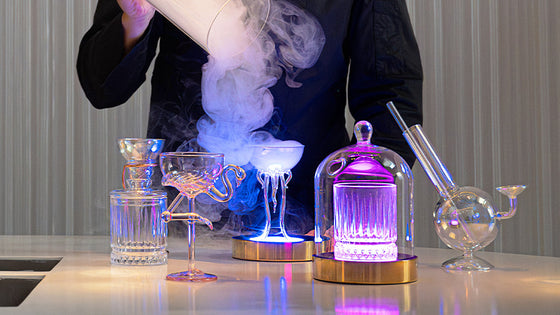The Five Senses Role in the Flavour of A Cocktail
The five senses are not just a science, but your house cocktail's smell, texture, and taste create a mentally stimulating customer experience. All bars serving food or drinks attempt to build a business based on sensual expectations met with satisfaction. Satisfaction is as much an emotional state as a chemical one. So let's take a peek at the journey of the senses when a customer chooses a mixed drink to see how we can better understand the customer expectations on that first sip.
Why Are We So Into Flavour?
Our need for food and water is primal. Our senses help us seek out what our body physically needs but also what meets our mental and emotional desires. When we talk about flavour, we can include all five senses.
Smell, sight, taste, texture and sound all contribute to our perceptions of flavour. Certain flavour chemicals motivate us to consume certain foods but can also lift our mood or evoke spontaneous emotions like surprise, nostalgia or joy. Add to that an environment that fosters stimulating conversation, and you've got a recipe for contentment. That's why so many businesses flourish on the foundations of cocktail flavours.
The Sensual Journey of a Cocktail
1. Airborne smells: You Walk into the Bar
Smell is not our most dominant sense, but it is usually our first point of perception. That's why coffee roasters and bakeries waft aromas onto bustling pavements. Our nose, throat and tongue combine to detect up to 1-trillion airborne olfactory odours. These trigger the chemical process of digestion. When we're hungry, our brains increase the production of AgRP neurones, which stimulate appetite and tell us to look for food. It's the first hook in a sale.
But these aroma cues also allow our subconscious to glean hazards, perceive pheromones, and intuit the emotional states of others. Our conscious mind will not only notice appetite cues but the memories and the emotions they elicit. They will make us feel favourably towards a venue, server or general atmosphere. They are the first 'vibes' your venue gives off.
2. Sound: You Take a Menu and Peruse to Find Something You Fancy
According to a growing body of research, an acoustic atmosphere can affect the way we taste. For example, noise over 100 decibels has been proven to affect sweet or salt perception intensity. A study on an aeroplane — where ambient sound is around 85 decibels — showed that the background noise intensified passenger's umami response. Another study showed that the mood of music affected wine drinkers description of the flavour profile. For example, when the music was mellow and soft, so was the wine.
If your ambient noise jars with the time of day, or the flavour profile of the drinks on your menu, you could be putting the guests off before they've even decided on what to drink. If your server is recommending certain drinks, see if you can match the flavour profile of the recipes to the type of music you pump into the atmosphere.
3. Sight: You Order A Drink
The description on your menu counts towards visualisation, as does your website or app. Visual stimulation is why so many people order drinks they see going out to other tables.
Vision is our primary sense. So Instagram has a lot to answer for because the current trend is to amp the visual flavour profile of a dish or drink up for a photograph rather than an appetite. Therefore, there's a proliferation of over garnished and under-seasoned goods served to an over-expectant public that are ultimately disappointing.
4. Sight and Scent: The Cocktail Arrives at Your Table
When you combine scent with visual cues, your body starts preparing for mechanical digestion. After we've eaten food, the body activates POMC neurones, proteins that make us feel satiated. The sight and smell of food alone is enough to trigger these 'satisfaction' POMC neurones in the brain, gearing up the whole digestive system not just for calories and nutrients but for the expectation of feeling satisfied afterwards.
You might begin to drool or have a gag reflex ready before a drink even touches your mouth. Extrinsic factors like colour and intrinsic factors like viscosity will drive acceptance or rejection. With just these initial two senses, we have built up an expectation of flavour that will make us either refuse or order a cocktail.
It's why we take a deep inhale when our cocktail arrives and take a moment to relish the experience. Just the smell of food-y notes like botanicals, citrus, fruits and vegetables can trigger these pleasurable neurones. That's why our garnishes are often flavour hints for the drink.
Over odour and you overwhelm the guest's palate and ruin the expectation of balance you've tried too hard to cultivate in the actual cocktail. No scent at all, and you miss the opportunity to add an extra dimension of sensuality to the guest experience.
At this point, your cocktail has passed several sensual tests, and the guest's body is primed and ready to enjoy the first biting cold sip of your recipe - or are they?
5. Texture: You Put the Glass to Your Lips
Naturally, you'd think taste comes next, but we perceive texture first. Grainy, slimy, sticky or thin, a drink's mouthfeel is the next to flag up a refusal reflex. Even if something tastes palatable, a gross texture or offbeat temperature will immediately make us question the admittance of a gulp into our bodies.
6. Taste: You Take a Sip
Our tongues help us to identify toxins, maintain nutrition, regulate appetite, create immune responses, and metabolise what we ingest via the sense of taste. A cocktail is essentially a toolbox of ingredients that, when balanced together, can affect any one of these responses in numerous different ways.
You'll notice our language puts emotions into flavour metaphors: people can be salty, bitter or have a zest for life. What flavours make you feel certain things? Do you have memories attached to certain scents or tastes?
How does your bar set up the sensual journey of the cocktail to the customer, and do you think their emotional and mental desires are met as well as their chemical need for a drink?
One of the reasons the Flavour Blaster helps venues get a return on their investment is because it's a tool that stimulates the visual and olfactory senses. Pair it well with a cocktail on your menu and you’ll create something that exceeds the customer expectations as many bar owners can testify.
Also Read - Matching Aromas to Aged Spirits
















